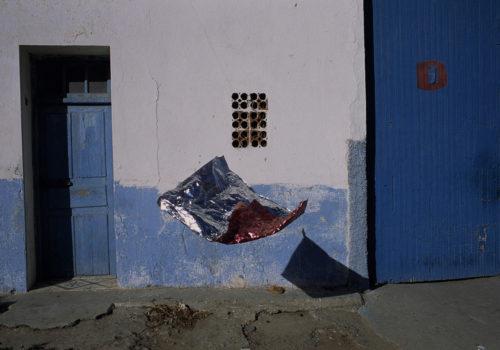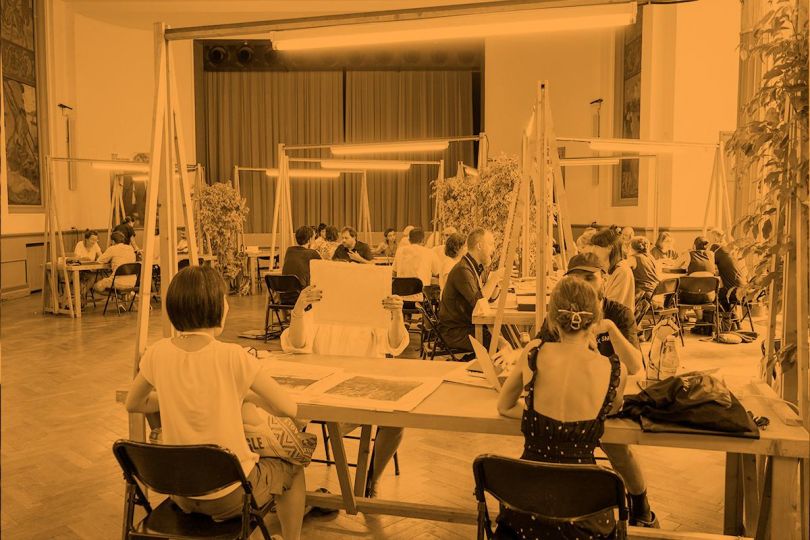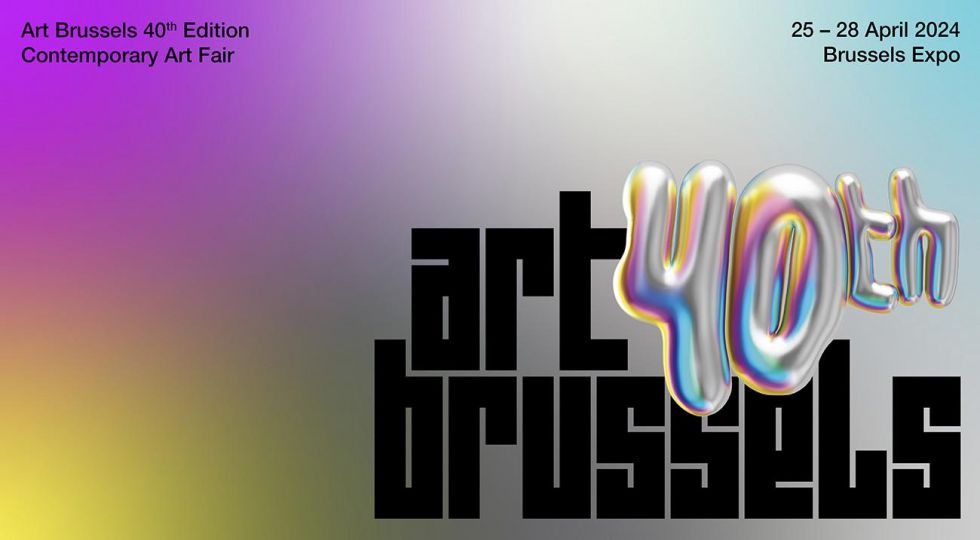Gallery Untitled Rotterdam – Vincent van de Wijngaard (1968, The Netherlands) (images 37)
Vincent van de Wijngaard’s work is characterized by a deft treatment of color and investigative style, giving rise to imagery of crisp detail and profound allure. Following an early interest in music and graphic design, he studied photography at The Royal Academy in The Hague. His projects have since taken him to more than seventy countries, fostering an appreciation and familiarity with diverse cultures that lends a unique international perspective to his work.
Van de Wijngaard’s command of narrative and comfort working in alternately stark and elaborate locations has led to assignments for Vogue US, Vogue UK, Vogue Italia, Interview US, Harpers Bazaar US, Financial Times, Zeit Magazin and many others. Van de Wijngaard’s commercial clients include Louis Vuitton, Cartier and Dior a.o .
His photographs and films have been collected and exhibited by museums and galleries worldwide. Van de Wijngaard’s feature length film, There is No Blue without Yellow and Orange, which charted the living and working environments of the painter, Vincent van Gogh, premiered at the National Art Center in Tokyo in 2010.
His book ‘Morocco’, published by Louis Vuitton, combines a selection of street photographs taken during many trips to Morocco. ‘Ghosts don’t walk in Straight Lines’, a multi-faceted exhibition with his partner in life Saskia de Brauw has been exhibited in New York, Paris, London and in Amsterdam at FOAM.
At Unseen 2023 Gallery Untitled will show a balanced group exhibition that conveys what we stand for: excellent technical skills with a modern look. We will debut with the works of internationally renowned photographer Vincent van de Wijngaard, showing his newest autonomous works. Iris5. Bergman published her book “Flowers for Mary’’ in November 2022, we will present her works and book of this series. “Hemelblauw’’, the popular piece of Lenny Oosterwijk will make place for his works of most recent skies and landscapes. Next to that we will present the newest cyanotypes of Dekkers & Co.
Gallery Untitled
Koningsveldestraat 14
Rotterdam.
www.galleryuntitled.nl
GRIMM Amsterdam/ NY/ London – Dirk Braeckman (Belgium) (images 38)
Since the mid-1980s, Dirk Braeckman has developed an impressive oeuvre of photography and video. Braeckman’s grey shaded works suggest rather than explain, offering a window into an ambiguous reality: distant seascapes, deserted ballrooms, billowing curtains, antique wallpaper, or a blurred image of a nude. Atmosphere, cropping, light and texture are given central place in Braeckman’s poetic work.
At this year’s edition of UNSEEN, GRIMM will present a series of works by Braeckman that demonstrate his distinctive, nebulous photographic perspective.
“Dirk Braeckman takes, eliminates, distorts, sculpts everything he sees. The sensuality of this inert world refers to the tactility of the photographic print itself, magnified by a matt paper and an extreme refinement of shades of grey. All shades of grey. Pearl grey, charcoal grey, silver grey, lizard grey, platinum grey, phoenix grey, slate grey, Lisbon grey, clock grey, moon grey… the infinite palette of monochrome.”
– Diane Dufour, 2022
Braeckman’s darkroom functions like a painter’s studio; an area for experimentation where the artist allows freedom, spontaneity and time to influence his creative process. Using tools and techniques to manipulate the negatives, the resulting works possess a tactility rarely seen in photography.
Based in Ghent, Belgium, Braeckman studied photography and film at the Royal Academy of Fine Arts in Ghent (BE) from 1977 to 1981. In 2017, Braeckman represented Belgium at the 57th Venice Biennale, Venice (IT), with an exhibition of work that challenged the convention of photography, applying his distinctive analogue technique to create a series of images of anonymous and dramatically charged subjects.
The list of exhibitions and collections in which Dirk Braeckman’s works features is exhaustive
GRIMM
Keizersgracht 241
1016 EA, Amsterdam The Netherlands
54 White Street
New York, NY 10013 United States
2 Bourdon Street
London, W1K 3PA United Kingdom
Homecoming Gallery Amsterdam – Alice Quaresma (1985 Brazil) (images 39)
Alice Quaresma was born in Brazil. After fifteen years of living in NYC, she’s now based in London. Her work explores identity through her landscape photographs of her hometown Rio de Janeiro and other parts of the world. Alice’s work reflects on ideas of transformation and (im)migration through her continuously evolving relationship with her hometown, changing as she grows and moves around the world.
For Unseen, Alice will be presenting all new works inspired by her recent move to London, combining photography, painting and collaging techniques in her unique pieces. ‘Moving to a new country changes perspectives of what is to come, making me look back to find ground while new life becomes familiar. I continue to investigate my own personal photo archive of Rio de Janeiro, but for these new pieces, I found myself drawn to Rio’s exceptional nature; mountains, forests, sea and sand. Nature is, now more than ever before, central to life and to us. Through my work I’ve been seeking connection again to that natural world. Old negatives with discolorations and minor ‘faults’ take a key role, deconstructed into new utopian landscapes with painted color marks marking my presence in the work. The geometrical shapes and colours take inspiration from the Neo Concrete art movement, which heavily influenced the Brazilian art scene in the 60s. This time, they take more fluid and organic shapes than in my earlier works.’
Homecoming Gallery Amsterdam – Derrick Ofosu Boateng (1983 Ghana) (images 40)
Derrick Ofosu Boateng is an autodidactic fine art photographer and the founder of the Hueism African Art movement. Inspired by the wisdom of African proverbs and the richness of the continent, he creates vibrant images that veer between visual poetry and conceptual art. Boateng employs his unique chromatic language, stark silhouettes, and ancient storytelling to challenge negative and limited perceptions of Africa. Since the onset of his artistic path, his photography and post-production have been entirely iPhone-based. Boateng’s work brims with energy, color and meaning, which are also the founding principles of the Hueist movement. Distinguished clients and subjects include Naomi Campbell, Louis Vuitton, and Common.
During UNSEEN his book HUEISM will be presented
Homecoming Gallery Amsterdam – Johnny Mae Hauser (1997 Germany/The Netherlands) (images 41)
Johnny Mae Hauser is a Dutch-German artist known for her abstract compositions, a gentle gaze in dramatically rich palettes, pushing the boundaries of photography and exploring the imaginative engagement of the medium. Each piece, an expression of the evolution of emotional memory in her distinctly sensible and colourful ways. Inspired by personal life experiences, her images exude a poetic stillness that captures the sentiments of life – introspection, isolation, intimacy and, ultimately, connection.
Homecoming Gallery
Online gallery
Amsterdam
www.homecoming.gallery
Hopstreet Gallery – Brussels/ Deurle Julie Cockburn (UK 1966) (images 42)
Julie Cockburn works with found images and objects, transforming them into new works of art. Using her own personal visual language, Cockburn embellishes carefully sourced second-hand photographs with embroidery, collage, screen printing and painting to produce her ongoing series of portraits and landscapes. Having trained as a sculptor, each composition plays a key role in the original photographs that Cockburn chooses. In addition, colour, texture and inherent meaning are fundamental to the decisions she makes when executing her transformations. Cockburn’s whole practice has a meditative quality apparent in the attention to detail and meticulous needlework in her embroidered works.
Hopstreet Gallery – Brussels/ Deurle – Sara Imloul (France 1986) (images 43)
In the age of digital images and social networks, Sara Imloul has chosen slowness, the Arte Povera of photography. “If I have kept this process, which is tedious and heavy, and which has a very long exposure time, it is because it also reminds me of the pose of models in painting. Basically, it is the scene that interests her and that is how she create this fictional diary.
With Passage (2015-18), a series that won the Prix Levallois, Sara Imloul narrows her gaze on her personal belongings, narrating an intimate typology with universal scope, an exhaustive and symbolic inventory at the intersection of nature, and self-portraits, sometimes with unusual elements, as if from a surrealist repertoire. Objects turn into traces, mental images into photographs, the past casually inscribing itself in an immobility as significant as it is spectacular. Exploring dimension through images.
Hopstreet Gallery – Brussels/ Deurle – Thorsten Brinkmann (Germany 1971) (images 44)
Thorsten Brinkmann reflects on contemporary society through playful and ironic juxtapositions of everyday objects, detritus, and references to art history. The works seem to oscillate effortlessly between the different genres and play with our collective visual memory. In particular his still life photographs and self-portraits have characteristics typical of Old Master’s compositions from the 16th and 17th century. For some viewers, the works also trigger associations with Dadaists and Surrealists or Duchamp’s readymades and they see the bizarre-absurd and ironic aspect of Brinkmann’s photographs first and foremost. For others, his photographs appear strange or even threatening in view of the fact that the body and face are consistently masked and the gender is sometimes ambivalent. Brinkmann’s works are actually all of that. The ambiguity is part of the concept.
Hopstreet
Rue Saint-Georges,
1050 Brussels Belgium
www.hopstreet.be
Ibasho Antwerp – Naohiro Ninomiya (1969 Japan) (images 45 )
Naohiro Ninomiya (1969) was born in Nagoya, Japan. After having worked in a company in Japan, he moved to France in 1998 and changed his direction to art. Ninomiya takes most of his photographs in his native region of Gifu, and prints and finishes them by himself in his atelier in France. The form of his work is very varied, because he is always looking for the appropriate support and technique for each project. Simply printing his negative images in his studio is not the goal of his work. He also wishes to engrave the moment of the atelier in his work. In the increasingly flat world he tries to make his work more rough and tangible.
At UNSEEN we will among others be introducing Ninomiya’s brand new series Nagare, about which the artist has stated the following:
“My native region, Gifu, is very mountainous. The river’s water flows swiftly towards the sea. The contrast between the large mountain rocks and the river’s current has always fascinated me. On one side, the rocks exhibit their immutability, while on the other, the river’s current reveals the transience of the present form. I decided to capture this contrast through photography. After developing the print, I applied bleach fluid with a brush to depict the waves. This step imbued me with a peculiar sensation. As I continued to move my brush, the waves of water movement emerged as if I were carving them. The river’s water was carving the mountain rocks, and this time, it was I who sculpted the river’s water.”
Ibasho Antwerp – Gert Motmans & Ronin de Goede (1972 & 1978 The Netherlands) (images 46 )
We are very proud to present a unique collaboration between the Belgian artist Gert Motmans and Dutch photographer Ronin de Goede:
Between nowhere and elsewhere The idea for “Between nowhere and elsewhere” began when Ronin reached out to Gert at the end of 2021 and stems from a mutual respect and appreciation for each other’s art.
Not being able to meet in person due to Covid restrictions Ronin decided to send a black box to Gert containing test strips and misprints from his previous series such as ‘Asakusa’, ‘Corvus black’ and ‘tales of solitude’ with the message “you have carte blanche” About a year later this resulted in a series of 12 unique hand cut collages .
“At the time when I received the box I was working on my series ‘now it’s day, but I am dreaming” so it took a while before I started going through the material Ronin sent me. I wanted to give the project my full attention and treat the work of Ronin with respect, I wanted to create something that would in a way glorify the existing image while being true to myself and my aesthetic. Our respective work has some parallels but we are also very different. I started by sorting out the images I was drawn to Intuitively and let the work arise from there.” – Gert Motmans
Motmans’ art is often influenced by modernism and so is this particular series, more specifically influenced by the work of onchi koshiro a Japanese print-maker from the 20th century and inspirer of the sõsaku-hanga movement, an art movement stressing the artist as the sole creator motivated by a desire for self-expression, and advocating principles of art that is “self-drawn” (自画 jiga), “self-carved” (自刻 jikoku) and “self-printed” (自摺 jizuri).
Ronin is inspired by both the everyday and the ephemeral. The ability to see in shades of grey allows him to focus on light and shadow, textures, shapes and expressions, bringing his studies in graphic design, fine art and painting at the Royal Academy of Fine Arts in The Hague into play.
His camera of choice is an analogue black Leica MP loaded with kodak 400 TRI-X. Eschewing digital photography and printing, he makes his own distinctive hand- made silver gelatine prints in a darkroom nestled in woodlands close to The Hague. Whether beneath this leafy shade or among the shadows crisscrossing the sun stroked streets of Asakusa, Ronin slips with ease from clogs to kimono, and can sometimes be spotted wearing both.
Ibasho
tolstraat 67
2000 Antwerp Belgium
www.ibashogallery.com
Kana Kawanishi Tokyo – Ai Iwane (1975 Japan/ US) (images 47 )
Ai Iwane has been continuously photographing the cherry blossoms in Fukushima since 2012. The cherry trees in Fukushima attracted thousands of tourists every spring, but since the 2011 earthquake-related nuclear power plant accident, it had always been only Iwane herself under the cherry blossoms in the radioactive evacuation zone.
In 2020, however, the new coronavirus pandemic created the same view across entire Japan. In April 2020, she was called for an assignment in Kitakami, Iwate prefecture (north of Fukushima). In Tenshochi park, Iwane encountered a two-kilometer (appx 1-1/4 miles) long tunnel of cherry blossoms in full bloom, with no one under them. This view inspired her to travel northward to see more cherry blossoms, and her secret journey began.
Since 2006, Iwane has focused on the Japanese community’s culture in Hawaii, and she settled her second base in Miharu, Fukushima, in 2013. She continuously examined the relevance between Hawaii and Fukushima from the aspect of immigration and put her research into her earlier work “KIPUKA” in 2018, which earned widespread acclaim and won the renowned Prix Pictet Japan Award (2022) and the Kimura Ihei Photography Award (2019).
Kana Kawanishi Tokyo Mayumi Suzuki (1977 Japan) (images 48)
Mayumi Suzuki was born in Onagawa, Miyagi Prefecture, to a photography studio that has been in operation for generations. Being deeply connected to photography from childhood, the narratives spun by her photographs have allowed viewers to find liberation through expression. Her debut series, “The Restoration Will,” was an intimate body of work where the artist calmly accepted the incidents that had happened to her and her family in the wake of the Great East Japan Earthquake, and gently, yet straightly, raised her head and looked forward. Her following series, “HOJO,” meaning “fertility” in English, is also based on her own experiences.
The starting point of “HOJO” was Suzuki’s encounter with unsold vegetables, such as a two-legged carrot she found on her way home from fertility treatment (IVF) that she had given up on. The work shows the chain of life by confronting the subject for approximately 60 seconds for a long exposure, a very short time for an internal examination, yet a carefully experienced time for photography.
A female nude, a deformed vegetable, and a fertilized egg, all of which appear to be independent subjects at first glance, are treated equally and inevitably in this work, and we are reminded that they are all the same as forms of life. The work also evokes a kind of freshness that does not resist things that transcend human knowledge.
Kana Kawanishi Tokyo – Tamami Iinuma (1983 Japan) (images 49)
Under the theme of “House of Architecture,” Tamami Iinuma photographs architecture as accumulations of people’s memories, and cities and landscapes as habitations of architecture. From 2008, Iinuma studied abroad at the Academy of Visual Arts Leipzig for a year and resided in Leipzig until 2013 (received the Grant for Overseas Study, Pola Art Foundation in 2010).
Her “Piece of Colonne. Fragments of Waves” series reflects her experiences and insight during her residency in Leiptich, and the colorful images compose a beautiful wave utilizing the pages of her concept photo book that serve as columns of architecture.
“When I was living on Industry Street in Leipzig, Germany, around 2009-2010, I found a dusty memo block in a tobacco and stationery store in the corner of Elster Passage near my apartment.The memo block was in the shape of a spiral, with seven colors of paper (light yellow, light red, light blue, dark yellow, dark red, dark blue, and green), with one side glued and more glossy than the other three. Attracted by the decorative nature of this block, I piled them up to make a “colonne/column” and photographed them under natural light. Using a macro lens and focusing beyond infinity, I could fuse the density, light, and shadow of the colors. When I looked through the viewfinder, the colors surged through me like a wave, and felt as if I could capture them by releasing the shutter. These photographs that resembled colored paper were created in this way.”
Kana Kawanishi Tokyo
2-7-5-5F, Nishi Azabu, Minato-ku,
Tokyo 106-0031 Japan
www.kanakawanishi.com
John Devos
Correspondent L’Œil de la Photographie/Eye of Photographie
john.devos01(a)gmail.com
















